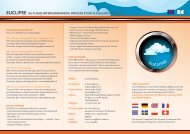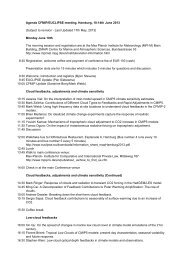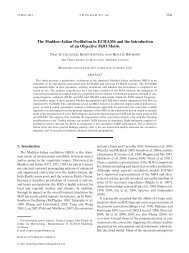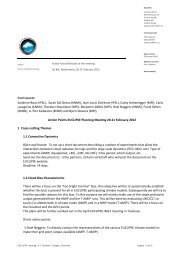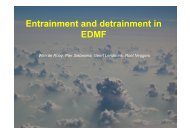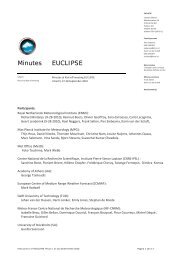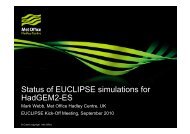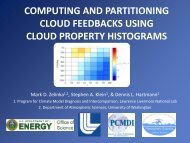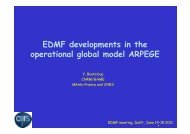EUCLIPSE First Period Report
EUCLIPSE First Period Report
EUCLIPSE First Period Report
Create successful ePaper yourself
Turn your PDF publications into a flip-book with our unique Google optimized e-Paper software.
Figure 8. Initial profiles of the total specific humidity qT, the liquid water potential<br />
temperature θL and the liquid water content qL. Squares denote bin-averaged observations<br />
over equal height intervals collected during flight A209. Error bars show ± one standard<br />
deviation from the mean.<br />
b. Composite Lagrangian intercomparison cases (MPI contribution)<br />
In addition to the ASTEX Lagrangian, three other transition cases are set up by Irina<br />
Sandu (MPI), which are based on satellite observations and ECMWF-INTERIM data in<br />
four of the eastern subtropical oceans where the stratocumulus to cumulus transitions<br />
typically occur, i.e. northeast, southeast, Atlantic and Pacific (Sandu et al., 2010).<br />
The data covers a six month period centered around the month with the highest mean<br />
cloud fraction in each area (i.e. May to October for the Northern Atmosphere and July<br />
to December for the southern one), spanning the period 2002-2007. A data selection<br />
was applied on the basis of environmental conditions, in order to obtain cases that are<br />
most likely to experience a transition. For each region a total number of 3000<br />
trajectories were used for statistical analysis.<br />
Sandu et al. divided the observed transitions in three categories, i.e. fast,<br />
intermediate and slow. They examined the differences between the fast and the slow<br />
transitions, and noticed only a little difference in the initial conditions of the clouds,<br />
including the median cloud fractions and optical thickness. They also found that<br />
environments in which the fast and the slow conditions occur are mainly distinguished<br />
by their values of SST and the lower tropospheric stability (LTS). Figure 9 shows the<br />
observed cloud fraction for the slow, intermediate and fast transitions and the SST,<br />
LTS and Div as obtained from the ECMWF-INTERIM data set. These results are used<br />
as large-scale forcing conditions for the three composite Lagrangian intercomparison<br />
cases. The observed cloud cover from the satellite data provides an excellent<br />
opportunity to verify model results. The ASTEX case mainly differs from the composite<br />
case in the sense that it has smaller jumps of humidity and temperature across the<br />
inversion layer compared to the composite cases (see Figure 10).<br />
25



